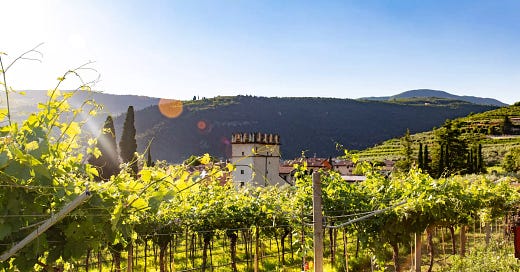North of Verona, tucked between Lake Garda and the Lessini Mountains, the undulating Valpolicella hills craft one of Italy’s most hedonistic reds, Amarone della Valpolicella DOCG. A blend led by Corvina (plus Corvinone and Rondinella), Amarone is made from grapes air‑dried for months (appassimento), concentrating sugars, acids, and phenolics. Fermentation then runs long and cool, producing a dry wine that marries 15–16 % alcohol with flavors of dried cherry, fig, dark chocolate, and a signature bittersweet finale.
Defining Traits of Amarone
Appassimento Concentration - 100 - 120 days of loft drying shrink berries by up to 40 %, intensifying fruit, spice, and glycerol richness.
Bittersweet Savory Edge - Oxidative hints of cocoa, espresso, and almond balance plush raisined fruit, giving Amarone its “amaro” (slightly bitter) name.
Aging & Alcohol - Minimum 2 years in oak (4 for Riserva), finishing at 15–16 % ABV yet retaining vibrant acidity from high‑elevation fruit.
Upgrade to Daily Terroir’s premium subscription for less than $3 a month
Terroir & Winemaking Deep Dive
The Classico zone’s limestone and basalt slopes (Fumane, Marano, Negrar, Sant’Ambrogio) yield fruit with both concentration and freshness. Grapes dry in ventilated fruttai; lofts where winter mountain breezes prevent rot. Slow winter fermentations (often >30 days) leave little sugar but plenty of texture. Traditionalists age in large Slavonian botti. Modernists favor 225–500 L French barrels for polish. Top bottles age gracefully for two decades, evolving from fig, sweet tobacco, and balsam to truffle, molasses, and forest floor.
Producers to Visit
Allegrini – Palazzo della Torre and flagship Amarone balance cherry liqueur, cocoa, and sleek tannins.
Dal Forno Romano – Powerhouse style → ultra‑dense dried plum, dark chocolate, and a graphite edge.
Giuseppe Quintarelli – Iconic artisanal estate; Amarone offers layered dried fruit, incense, and endless length.
Travel Spotlight – Exploring Valpolicella
Stay
Villa Cordevigo Wine Relais – 18th‑century estate turned boutique hotel with an on‑site cellar and cypress‑lined pool overlooking vineyards.
Dine
Osteria La Fontanina (Verona) – Century‑old restaurant serving braised beef cheeks in Amarone sauce.
Swirl
Antica Bottega del Vino (Verona) – Historic enoteca pouring vertical flights of Amarone and Recioto. Pair a glass with Monte Veronese cheese before strolling Verona’s marble streets.
Quiz
How does the appassimento process impact Amarone’s balance of alcohol, acidity, and tannin compared with fresh‑fruit ferments?
Why might limestone‑basalt soils in the Classico valleys contribute both richness and freshness to Amarone’s final profile?






